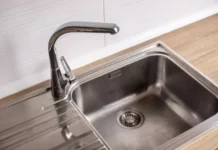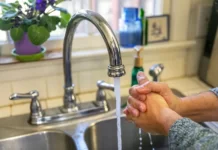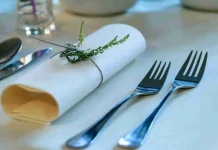Is Nonstick crockery our choice? This is the reason we always try to figure out of converting pans into nonstick by seasoning them.
In the kitchen, non-stick pans are incredible for a quick clean-up, however, their quality of being non-stick can damage slowly with time, especially if not handled correctly.
Stains or scratches to the surface of the non-stick layer make the pans less effective and stick, which can be really annoying if you have spent lavishly on a fancy pan.
The pans are great until they stop working. Fortunately, you can make a stick pan into a non stick pan by cleaning and seasoning them with oil to remove the marks and strengthen their non-stick layer.
As compared to buying a new replacement, seasoning your non-stick pan is a simple and quick process and far cheaper.
In this article, we will focus on how to make a pan non stick. Let’s start.
Methods to make a pan non stick
1. Use vegetable Ghee/ Coconut oil
- Take a pan that needs seasoning.
- Pour oil with a high melting point, like vegetable ghee or coconut oil.
- Spread the oil evenly on the pan.
- You can use an oven at 300 degrees or heat the pan for 2 minutes.
- Let the oil cool by turning off the burner.
- This will help to make the pan’s surface no sticky and smoother.
- The properly seasoned pan is seasoned properly if you are able to see your own reflection.
- Clean out the extra oil with a paper towel now and use the pan for cooking purposes.
- The same process must be followed every time if you put the pan in the dishwasher.
2. Use Table Salt to make non stick
- Take a pan that needs seasoning.
- Take one cup of table salt and put it on the pan.
- Spread the salt evenly to cover the whole surface of the pan and heat it.
- Take the salt out to be extra careful, it will be very hot
- The same process must be followed every time you want to make it non sticky.
3. Make a pan nonstick with salt and oil
- The third method is to use both salt and oil together.
- Use any oil with a high melting point like sunflower oil.
- Use two tablespoons of salt.
- Heat till it reaches the smoking point
- Now remove the extra oil and clean the remaining salt and oil from the pan by using a paper towel.
- The properly seasoned pan has a reflective surface.
- Repeat the process every time to make it nonstick.

How to make a non stick pan Non stick again
Food slides off with a new non-stick pan. But with time, the non-stick layer damages, and scratches and food starts to stick, before you know it. Luckily there are some steps to make the pans non-stick again.
All you need is
- Baking soda
- Dishtowel
- Dish soap
- Paper cloth or towel
- Canola or vegetable oil
- Soft-bristled brush
Instructions
- Clean the pan normally with warm soapy water.
- On the surface, apply a half cup of baking soda with the addition of a few drops of water to form a thick paste.
- The soft-bristled brush is used to scrub the pan for some time. This will help to wipe off any build-up.
- Rinse off the baking soda, once the pan is clean, and dry the pan properly.
- Turn on the high flame and place the pan on it.
- Heat till the pan is really hot.
- Add vegetable or canola oil over the pan’s surface. Spread by using a clean paper towel. An oven mitten or tongs are used to avoid burning your hand.
- Over medium flame, heat the pan for 1-2 minutes more.
- Allow it to cool down completely.
- With a cloth or paper towel wipe off the extra oil. Now the pan is safe to use a non-stick pan.
How to make a Bare Cast Iron Skillet Non-stick
This type of cookware is very durable with perfect and unmatched retention of heat.
But, this cookware requires proper maintenance and seasoning to remain and become non-stick.
The things required are:
- Dishtowel
- Oven
- Baking tray
- Brillo pad
- Dish soap
- Separate cloth
- Aluminum foil
Instructions
- The oven is preheated to 350 degrees F.
- Under hot water, rinse the pan.
- To a Brillo pad, apply some dish soap. Scrub gently both sides of the pan in circular motions.
- Wash with hot water.
- Properly dry with a dishtowel.
- Apply solid shortening or vegetable oil to a clean piece of cloth. Apply to the whole pan, internally and externally.
- Take a piece of aluminum foil and place it on the top of the baking tray. Put the cast iron skillet in the oven for 1-2 hours upside down on top.
- Turn off the oven with the removal of the pan. Allow it to cool down completely in the oven. The seasoning gets locked because of seasoning.
- Clean the pan with a cloth to remove extra oil.
How to minimize food sticking to the pan while cooking
Seasoning is the first step when it comes to making a pan non-stick. There are some tips to minimize food sticking while cooking.
- Before you start cooking, make sure the pan is always clean.
- Before adding butter or oil, heat the pan. Add food, once the pan is greased well and hot.
- Perform the water test. Add a few drops of water, once the pan is heated. If water glides and sizzles, the pan is then ready for the addition of oil.
- Allow the ingredients to gain normal room temperature before adding them to the pan.
- Before cooking, dry the food and remove any extra moisture with the help of a paper towel.
The Bottom Line
Proper cooking techniques must be followed with premium-quality cookware, or the food will stick inevitably, as the pan wears down. By following these simple methods you can get answers to your question that how to make a pan non stick or even restore non-stick pans.














